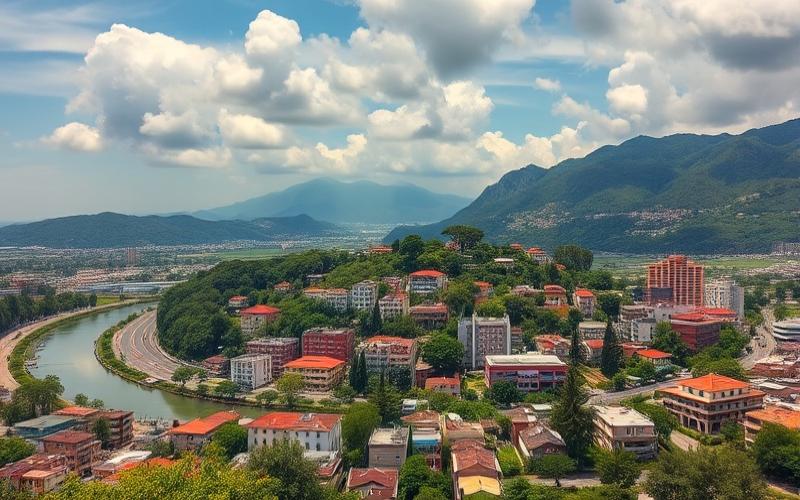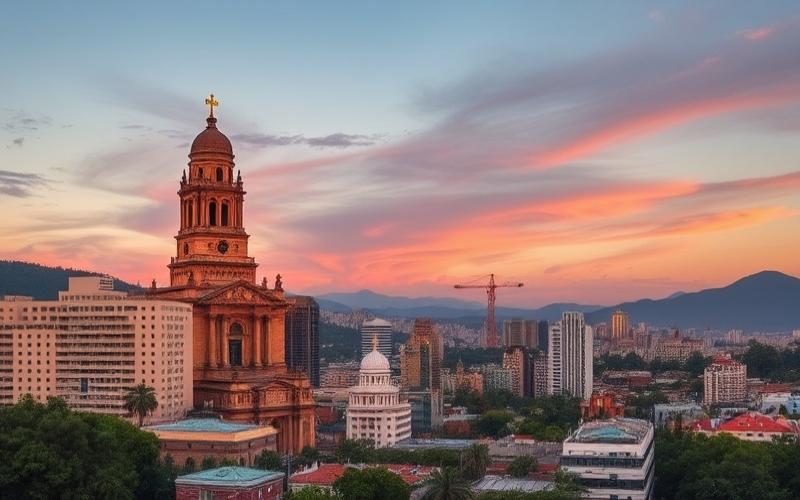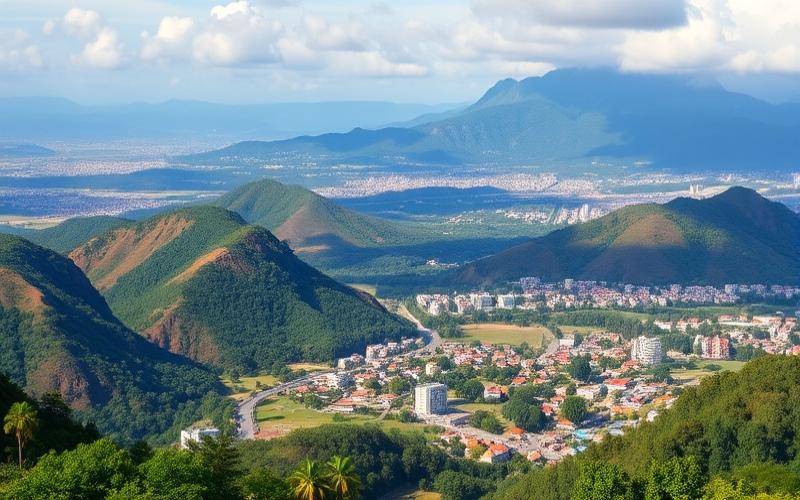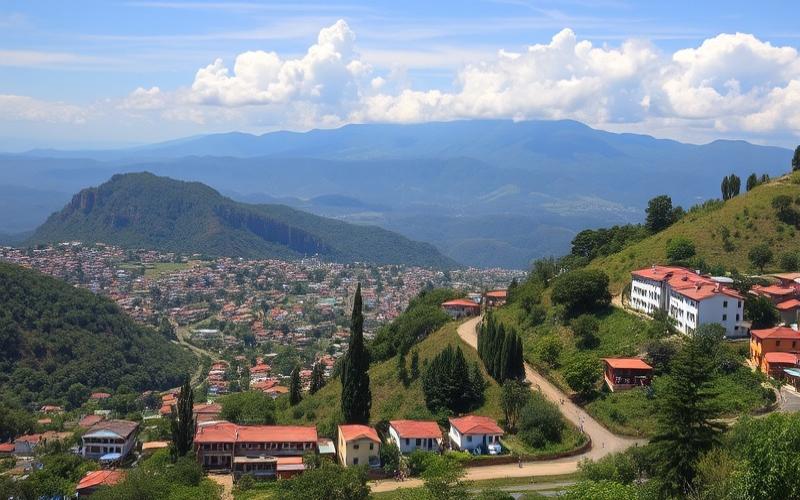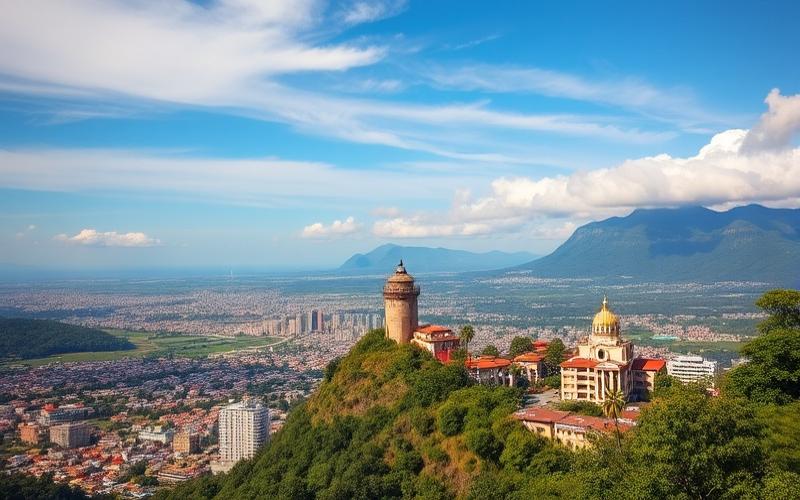
 Published on and written by Cyril Jarnias
Published on and written by Cyril Jarnias
Traveling through El Salvador can seem confusing for the uninitiated, but immersing yourself in its public transportation system reveals a vibrant and dynamic world to discover.
While it may appear chaotic at first glance, understanding the organization of colorful buses and the surprising efficiency of services from the capital, San Salvador, to the country’s small picturesque towns offers an authentic and economical experience.
This practical guide will not only provide you with essential tips on using the main means of transportation, but will also immerse you in cultural and local nuances, ensuring an enriching and hassle-free journey.
Discovering Transportation Modes in El Salvador
El Salvador offers several public transportation modes, mainly buses, minibuses (microbuses, colectivos), and taxis.
| Transportation Mode | Frequency | Cost (Approximate) | Main Routes/Areas Served | Advantages | Disadvantages |
|---|---|---|---|---|---|
| Urban and Intercity Buses | Very frequent, especially during the day (departures every 10-20 minutes on major routes) | $1 to $2 per hour of travel | San Salvador, Santa Ana, San Miguel, routes 2, 8, 9A, 10, 11, 12, 17B, 22, 26, 27, 29, 30A, 34A, 34B, 41, 42B, 46, 46B, 48, 53, 79, 101, 101A, 101B, 101C, 102, 152 | Very economical, extensive network, accessible | Can be crowded, variable safety depending on time/neighborhood, limited comfort |
| Minibus (microbus, colectivos) | High frequency on main arteries | Similar to buses, sometimes slightly higher | Historic center of San Salvador, routes like 138LP | Faster than buses, serves neighborhoods not covered by large buses | Less space, sometimes overcrowded, flexible stops (less predictable) |
| Taxis | Available 24/7 in large cities, possible wait during rush hour | $20 to $40 airport-San Salvador, variable in the city | Airport, hotels, terminals, downtown | Convenient, direct, superior safety, time-saving | More expensive, need to negotiate fare, language barrier, not always metered |
Main Infrastructure and Recent Innovations
- Modern terminals exist in San Salvador: Terminal de Buses del Sur, Terminal de Occidente, Terminal de Oriente Plaza Amanecer.
- Gradual deployment of mobile applications to better know schedules and routes in real time (check VMT social networks).
- Historic center revitalization projects in San Salvador have led to route changes and the creation of new pedestrian paths.
- Private transfer and ride-hailing services (like airport shuttles and local platforms) are developing, offering more security and comfort.
Practical Tips for Travelers
- Plan your route in advance, as bus and minibus routes can change due to construction or events.
- Use main bus terminals when possible for more security and clarity on departures.
- Prefer official taxis or book through your hotel; negotiate the price before getting in, as meters are rare.
- Avoid traveling at night on public transportation, especially in less frequented areas.
- Keep an eye on your personal belongings and avoid displaying valuables in transit.
- For intercity trips or to neighboring countries, prefer recognized companies like Ticabus and Pullmantur.
Key Takeaways
- The bus remains the most economical and widespread means.
- Taxis are more comfortable but significantly more expensive.
- Minibuses offer a good speed/price compromise but are less predictable.
- Infrastructure is improving, but flexibility and caution remain essential for peaceful travel.
Good to Know:
Opt for “red buses” for lower cost, but expect delays; prefer regulated taxis for more safety, especially at night. Learn a few words in Spanish to facilitate exchanges with minibus drivers.
Planning Your Transportation Budget Like an Expat
Types of Public Transportation in El Salvador
Urban and Intercity Buses
The bus network is the main means of public transportation in El Salvador. There are traditional buses, often colorful and recognizable, serving both the capital San Salvador and secondary cities. Trips between the international airport and downtown take about 45 minutes to an hour, but schedules can be irregular.
Minibus (microbuses)
Minibuses, locally called “microbuses,” are very popular for urban and suburban travel. They run on fixed routes and stop on demand. Faster than large buses, they are also a bit more expensive but remain economical.
Shared taxis operate like shared minibuses: they follow a predefined route and pick up multiple passengers at once. They are an intermediate option between private taxis (more expensive) and public buses (less comfortable).
Private Taxis
Private taxis are available in all major cities. They are convenient for occasional or nighttime travel but significantly more expensive than collective transport. Some platforms also offer premium services with air-conditioned cars and English-speaking drivers.
| Transport Type | Approximate Cost | Advantages | Disadvantages |
|---|---|---|---|
| Urban Bus | Less than a dollar per trip | Very affordable | Irregular schedules |
| Minibus | $1 to $2 | Faster than large buses | Slightly more expensive |
| Shared Taxis | Variable by trip | Economical intermediate option | Less comfortable |
| Private Taxis | ~$30 airport-downtown | Convenient and direct | Significantly more expensive |
Estimating Your Monthly Transportation Budget
You need to consider the frequency of daily or weekly trips as well as the distance traveled.
- Daily Commute: Multiply the cost of a round trip by the number of workdays.
- Occasional Trips: Add a few extra trips for outings or errands.
- Economical Option: Systematically prefer public buses or minibuses when possible.
- Special Cases: For some expats living far from downtown or needing flexible hours, budget extra for a few private taxi rides.
Example: An expat making ten round trips per week by minibus would spend about 10 × $2 × 4 = $80 per month excluding exceptional trips.
Subscriptions and Transportation Cards
To date, there is no national subscription or rechargeable card offering discounts to regular users. Each trip is paid separately to the driver or conductor. However, some employers sometimes offer partial subsidies on transportation costs, especially in the formal sector; it may be useful to inquire with the local HR department.
Useful Applications
Although El Salvador does not yet have an official national application covering the entire network, several solutions exist to facilitate travel.
- Use Google Maps, which is gradually integrating some local schedules.
- Check Marvelus Travel to book tickets online on certain tourist routes.
- Compare prices/options with Viator when planning your trips.
Good to Know:
To optimize your transportation budget in El Salvador, prioritize buses and shared taxis for low cost and study monthly subscriptions to reduce regular expenses; use apps like Moovit to plan your trips while considering recommended safety measures.
Tips for a Peaceful Journey on Public Transportation
To travel efficiently and safely in El Salvador, it is essential to adopt practices adapted to the local context:
Practical Tips for Public Transportation
Available Transportation Types
- Urban buses (often old and crowded)
- Microbus (minibuses serving fixed routes)
- Official taxis and ride-hailing (Uber, inDriver)
- Intercity buses for long distances or neighboring countries
Tips for Buying Tickets
- Carry small change, as tickets are usually sold on board by the driver or a conductor.
- Ask the price before boarding to avoid misunderstandings.
- For long-distance trips, prefer recognized companies (e.g., King Quality, Pullman Tour) and buy tickets in advance at the bus station.
Anticipating Delays
- Schedules are often approximate; allow extra time for connections.
- Buses can be delayed by traffic, especially during rush hours (generally from 6:30 AM to 8:30 AM and 4:30 PM to 7 PM).
Using Local Applications
- Download apps like Moovit or Google Maps to get real-time routes and schedules.
- WhatsApp is frequently used to communicate with drivers or local companies.
Safety and Vigilance
Keep Your Belongings Safe
- Wear a bag in front of you on transportation.
- Avoid taking out your phone or valuables in public.
- Always keep an eye on your luggage, especially in bus stations and markets.
Vigilance Against Pickpockets
- Crowds are conducive to pickpocketing, especially on crowded buses and at main stops.
- Prefer trips outside rush hours to limit risks.
Other Precautions
- Do not travel at night, especially outside main arteries or in unfamiliar neighborhoods.
- Use only official taxis or ride-hailing services recommended by your accommodation.
Cultural Tips for Harmonious Integration
Respecting Local Customs
- Greet and thank politely (frequent use of “buenos días,” “gracias”).
- Dress discreetly, especially outside tourist areas.
- Avoid photographing people without their consent, especially on transportation.
- Punctuality is not always a local priority; patience is appreciated.
- In case of checks or interactions with police, remain calm, courteous, and present your ID without protest.
Summary of Key Points
| Theme | Main Recommendations |
|---|---|
| Rush Hours | Avoid 6:30-8:30 AM and 4:30-7 PM to limit crowds |
| Belongings Safety | Keep bag in front, avoid visible valuables |
| Transport Types | Buses, microbuses, official taxis, ride-hailing, intercity buses |
| Ticket Purchase | Carry change, buy on board or at station, ask fare beforehand |
| Delays and Schedules | Allow extra time, check via apps, schedules often approximate |
| Useful Apps | Moovit, Google Maps, WhatsApp |
| Cultural Tips | Greet, dress discreetly, patience, respect privacy, cooperate with authorities |
⎯⎯⎯⎯⎯⎯⎯⎯⎯⎯⎯⎯⎯⎯⎯⎯⎯⎯⎯⎯⎯⎯⎯⎯⎯⎯⎯⎯⎯⎯⎯
Respecting local customs, caution in transportation, and using digital tools are the keys to a peaceful stay in El Salvador.
⎯⎯⎯⎯⎯⎯⎯⎯⎯⎯⎯⎯⎯⎯⎯⎯⎯⎯⎯⎯⎯⎯⎯⎯⎯⎯⎯⎯⎯⎯⎯
Good to Know:
Avoid rush hours between 6-8 AM and 5-7 PM for a peaceful experience, use apps like “Moovit” for real-time information, and stay vigilant against pickpockets by keeping your belongings close; be respectful on buses and microbuses by considering local customs, such as giving up your seat to the elderly or pregnant women.
Disclaimer: The information provided on this website is for informational purposes only and does not constitute financial, legal, or professional advice. We encourage you to consult qualified experts before making any investment, real estate, or expatriation decisions. Although we strive to maintain up-to-date and accurate information, we do not guarantee the completeness, accuracy, or timeliness of the proposed content. As investment and expatriation involve risks, we disclaim any liability for potential losses or damages arising from the use of this site. Your use of this site confirms your acceptance of these terms and your understanding of the associated risks.






